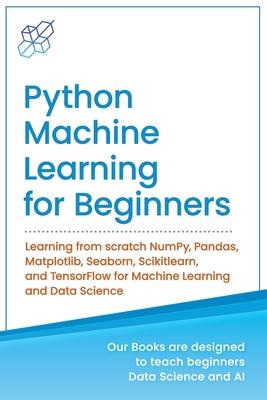Machine Learning (ML) and Artificial Intelligence (AI) are here to stay. Yes, that's right. Based on a significant amount of data and evidence, it's obvious that ML and AI are here to stay.Consider any industry today. The practical applications of ML are really driving business results. Whether it's healthcare, e-commerce, government, transportation, social media sites, financial services, manufacturing, oil and gas, marketing and salesYou name it. The list goes on. There's no doubt that ML is going to play a decisive role in every domain in the future.But what does a Machine Learning professional do?A Machine Learning specialist develops intelligent algorithms that learn from data and also adapt to the data quickly. Then, these high-end algorithms make accurate predictions.
Python Machine Learning for Beginners presents you with a hands-on approach to learn ML fast.
How Is This Book Different?AI Publishing strongly believes in learning by doing methodology. With this in mind, we have crafted this book with care. You will find that the emphasis on the theoretical aspects of machine learning is equal to the emphasis on the practical aspects of the subject matter.You'll learn about data analysis and visualization in great detail in the first half of the book. Then, in the second half, you'll learn about machine learning and statistical models for data science.Each chapter presents you with the theoretical framework behind the different data science and machine learning techniques, and practical examples illustrate the working of these techniques.When you buy this book, your learning journey becomes so much easier. The reason is you get instant access to all the related learning material presented with this book-references, PDFs, Python codes, and exercises-on the publisher's website. All this material is available to you at no extra cost. You can download the ML datasets used in this book at runtime, or you can access them via the Resources/Datasets folder.You'll also find the short course on Python programming in the second chapter immensely useful, especially if you are new to Python. Since this book gives you access to all the Python codes and datasets, you only need access to a computer with the internet to get started.
The topics covered include:
- Introduction and Environment Setup
- Python Crash Course
- Python NumPy Library for Data Analysis
- Introduction to Pandas Library for Data Analysis
- Data Visualization via Matplotlib, Seaborn, and Pandas Libraries
- Solving Regression Problems in ML Using Sklearn Library
- Solving Classification Problems in ML Using Sklearn Library
- Data Clustering with ML Using Sklearn Library
- Deep Learning with Python TensorFlow 2.0
- Dimensionality Reduction with PCA and LDA Using Sklearn
